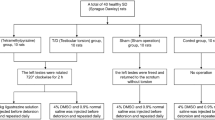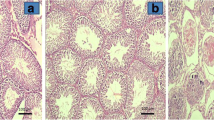Abstract
This study was designed to investigate the effect of selenium on ipsilateral and contralateral testicular damage after unilateral testicular torsion/detorsion (T/D). Thirty-two male rats were divided into four groups, each containing eight rats. Torsion was created by rotating the right testis 720° in a clockwise direction. Group 1 underwent sham operation to determine basal values for biochemical and histopathological evaluation. Sham operation was performed in group 2, and sodium selenate (0.2 mg/kg) was given intraperitoneally. Group 3 served as a T/D group, receiving 4-h torsion and 4-h detorsion. Similarly, in group 4 sodium selenate (0.2 mg/kg) was injected intraperitoneally 20 min before detorsion. Bilateral orchiectomies were performed for measurement of tissue malondialdehyde (MDA) levels and superoxide dismutase (SOD) activities and histopathologic examination. The results were compared statistically. The highest MDA and the lowest SOD values were determined in both testes in group 3. There were statistically significant differences in MDA levels and SOD activities in group 3 compared with group 4. Specimens from group 3 had a significantly greater histologic injury than other groups. These results suggest that ischemia-reperfusion injury occurred in both testes after unilateral testicular T/D and that selenium administration before detorsion prevents reperfusion injury in testicular torsion.





Similar content being viewed by others
References
Goldwasser B, Weissenberg R, Lunenfeld B, Nativ O, Many M (1984) Semen quality and hormonal status of patients following testicular torsion. Andrologia 16:239–243
Thomas WEG, Cooper MJ, Crane GA, Lee G, Williamson RCN (1984) Testicular exocrine malfunction after torsion. Lancet 2:1357–1360
Prilman HM, Turner TT (1997) Rescue of testicular function after acute experimental torsion. J Urol 157:340–345
Reilly PM, Schiller HJ, Bulkley GB (1991) Pharmacologic approach to tissue injury mediated by free radicals and other reactive oxygen metabolites. Am J Surg 161:488–503
Carden DL, Granger DN (2000) Pathophysiology of ischemia reperfusion injury. J Pathol 190:255–266
Bulger EM, Maier RV (2001) Antioxidants in critical illness. Arch Surg 136:1201–1207
Arora AS, Gores JG (1996) The role of metals in ischemia reperfusion injury of the liver. Semin Liver Dis 16:31–38
Ursini F, Bindoli A (1987) The role of selenium peroxidases in the protection against oxidative damage of membranes. Chem Phys Lipids 44:255–276
Lockitch G (1989) Selenium: clinical significance and analytical concepts. Criti Rev Clin Lab Sci 27:439–541
Soncul H, Tatlıcan O, Halit V, et al. (1994) The effect of selenium added cardioplegia in guinea pigs. Gen Pharm 25:1493–1497
Erbas D, Soncul H, Türkozkan N, et al. (1995) Effect of selenium on ischemic and reperfusion injury in isolated guinea pig lungs. Gen Pharmacol 26:1669–1672
Zaptelal C, Heyne S, Golling M, Kraus T, et al. (2001) Influence of selenium therapy on liver microcirculation after warm ischemia/reperfusion: an intravital microscopy study. Transplant Proc 33:974–975
Nath KA, Paller MS (1990) Dietary deficiency of antioxidants exacerbates ischemic injury in the rat kidney. Kidney Int 38:1109–1117
Durak I, Kocaoğlu H, Kaçmaz M, Çimen MYB, Büyükkoçak S, Öztürk S (1998) Antioxidant potential, oxidation resistance and MDA levels of cancerous and noncancerous human colorectal tissues. Cancer Res Ther Control 5:295–299
Durak I, Canbolat O, Kavutcu M, Öztürk H S, Yurtarslanı Z (1996) Activities of total, cytoplasmic and mitochondrial superoxide dismutase enzymes in sera and pleural fluids from patients with lung cancer. J Clin Lab Anal 10:17–20
Van Ye TM, Roza AM, Pieper GM Jr, Henderson J, Johnson CP, Adams MB (1993) Inhibition of intestinal lipid peroxidation does not minimize morphological damage. J Surg Res 55:553–558
Lowry O, Rosebrough N, Farr L, Randall R (1951) Protein measurement with folin phenol reagent. J Biol Chem 182:265–275
Cosentino MJ, Nishida M, Rabinowitz R, Cockett ATK (1986) Histopathology of prepubertal rat testes subjected to various durations of spermatic cord torsion. J Androl 7:23–31
Costabile RA, Choyke PL, Frank JA, Girton ME, Diggs R, Billups KL, Desjardins C (1994) Variability of ischemia during spermatic cord torsion in rat. J Urol 151:1070–1072
Akgür F, Kılınç K, Tanyel FC, et al. (1994) Ipsilateral and contralateral testicular biochemical acute changes after unilateral testicular torsion and detorsion. Urology 44:413–418
Lievano G, Nguyen L, Radhakrishnan J, et al. (1999) New animal model to evaluate testicular blood flow during testicular torsion. J Pediatr Surg 34:1004–1006
Harrison RG, Lewis-Jones DI, Moreno de Marval MJ, Connolly RC (1981) Mechanism of damage to the contralateral testis in rats with an ischemic testis. Lancet ii:723–725
Nagler HM, White RV (1982) The effect of testicular torsion on the contralateral testis. J Urol 128:1343–1348
Wallace DMA, Gunther PA, Landon GV, Pugh RBC, Hendry WF (1982) Sympathetic orchiopaty—an experimental and clinical study. Br J Urol 54:765–768
Tanyel FC, Buyukpamukcu N, Hicsönmez A (1989) Contralateral testicular blood flow during unilateral testicular torsion. Br J Urol 63:522–524
Turner TT (1985) Acute experimental testicular torsion. No effect on the contralateral testis. J Androl 6:65–72
Madgar I, Lunenfeld B, Mashiacs S, Goldwasser B, Weissenberg R (1987) Effect of testicular torsion on contralateral testis and fertility in mature rats. Arch Androl 19:237–241
Mc Cord JM (1985) Oxygen derived free radicals in post ischemic tissue injury: mechanism of disease. N Eng J Med 312:159–163
Özokutan BH, Küçükaydın M, Muhtaroğlu S, et al. (2000) The role of nitric oxide in testicular ischemia—reperfusion injury. J Pediatr Surg 35:101–103
Ozturk H, Buyukbayram H, Ozdemir E, Ketani A, Gürel A, Onen A, Otcu S (2003) The effects of nitric oxide on the expression of cell adhesion molecules (ICAM-1,UEA-1 and tenascin) in rats with unilateral testicular torsion. J Ped Surg 38:1621–1627
Bauché JF, Fouchard MH, Jégou B (1994) Antioxidant system in rat testicular cell. FEBS Lett 349:392
Saba M, Morales CR, De Lamirende E, Gagnon C (1997) Morphological and biochemical changes following acute unilateral testicular torsion in prepubertal rats. J Urol 157:1149–1154
Albrecht S, Zimmermann T, Ockert D, Oelschlager S, Heinzmann J, Schilling JU (1997) Does selenium prevent peroxynitite formation from NO in vascular surgery interventions? A clinical study. Med Klin 15:10–13
Gupta R, Singh M, Sharma A (2003) Neuroprotective effect of antioxidants on ischemia and reperfusion induced cerebral injury. Pharmacol Res 48:209–215
Ozturk C, Avlan D, Cinel I, Cinel L, Unlu A, Camdeviren H, Atik U, Oral U (2002) Selenium pretreatment prevents bacterial translocation in rat intestinal ischemia/reperfusion injury. Pharmocol Res 46:171–177
Abraham E (2000) NF-kB activation. Crit Care Med 28:N100-N104
Tolando R, Jovanovic A, Brigelius-Flohe R, Ursini F, Maiorino M (2000) Reactive oxygen species and proinflammatory cytokine signaling in endothelial cells: effect of selenium supplementation. Free Radic Biol Mol 28:978–986
Maehira F, Miyagi I, Eguchi Y (2003) Selenium regulates transcription factor NF-kB activation during the acute phase reaction. Clin Chim Acta 334:163–171
Author information
Authors and Affiliations
Corresponding author
Rights and permissions
About this article
Cite this article
Avlan, D., Erdouğan, K., Çimen, B. et al. The protective effect of selenium on ipsilateral and contralateral testes in testicular reperfusion injury. Ped Surgery Int 21, 274–278 (2005). https://doi.org/10.1007/s00383-005-1365-1
Accepted:
Published:
Issue Date:
DOI: https://doi.org/10.1007/s00383-005-1365-1




